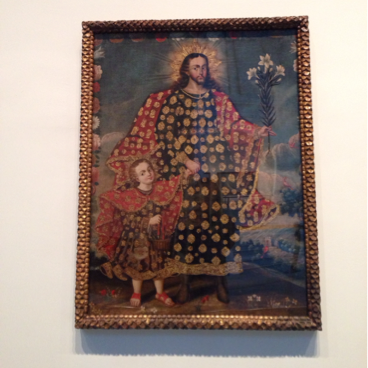
Saint Joseph and the Christ Child
Cuzco School
American Art
A number of paintings of favorite saints sometimes decorated a bedroom. (The 1784 inventory of Manuel Herrera in Oruro, in present-day Bolivia, lists more than fifty religious paintings in the alcoba.) This Cuzco school image of Saint Joseph, who also served as the patron saint of the Good Death, would have been an apt work for a bedchamber, where it would have watched over evening prayer and sleep. Images of Saint Joseph came into vogue in ecclesiastical and domestic contexts throughout the empire after 1679, when King Charles II named him the patron saint of the Spanish monarchy.
Pinturas de los santos favoritos solían decorar el dormitorio. (El inventario de 1784 de Manuel Herrera en Oruro, en la actual Bolivia, enumera más de cincuenta pinturas religiosas en la alcoba.) Esta imagen de la escuela de Cuzco de San José, que también era el santo patrono de la Buena Muerte, era una obra apropiada para un dormitorio, donde hubiese presidido la oración vespertina y el sueño. Las imágenes de San José se pusieron de moda en contextos eclesiásticos y domésticos en España y sus territorios después de 1679, cuando el Rey Carlos II lo denominara santo patrono de la monarquía española.
Pinturas de los santos favoritos solían decorar el dormitorio. (El inventario de 1784 de Manuel Herrera en Oruro, en la actual Bolivia, enumera más de cincuenta pinturas religiosas en la alcoba.) Esta imagen de la escuela de Cuzco de San José, que también era el santo patrono de la Buena Muerte, era una obra apropiada para un dormitorio, donde hubiese presidido la oración vespertina y el sueño. Las imágenes de San José se pusieron de moda en contextos eclesiásticos y domésticos en España y sus territorios después de 1679, cuando el Rey Carlos II lo denominara santo patrono de la monarquía española.
ARTIST
Cuzco School
MEDIUM
Oil on canvas
DATES
late 17th–18th century
DIMENSIONS
43 x 32 1/8in. (109.2 x 81.6cm)
frame: 45 11/16 x 35 1/16 x 2 1/2 in. (116 x 89.1 x 6.4 cm) (show scale)



COLLECTIONS
American Art
ACCESSION NUMBER
41.1275.191
CREDIT LINE
Museum Expedition 1941, Frank L. Babbott Fund
MUSEUM LOCATION
This item is not on view
CAPTION
Cuzco School. Saint Joseph and the Christ Child, late 17th–18th century. Oil on canvas, 43 x 32 1/8in. (109.2 x 81.6cm). Brooklyn Museum, Museum Expedition 1941, Frank L. Babbott Fund, 41.1275.191 (Photo: Brooklyn Museum, 41.1275.191_SL3.jpg)
IMAGE
overall, 41.1275.191_SL3.jpg. Brooklyn Museum photograph
"CUR" at the beginning of an image file name means that the image was created by a curatorial staff member. These study images may be digital point-and-shoot photographs, when we don\'t yet have high-quality studio photography, or they may be scans of older negatives, slides, or photographic prints, providing historical documentation of the object.
RIGHTS STATEMENT
No known copyright restrictions
This work may be in the public domain in the United States. Works created by United States and non-United States nationals published prior to 1923 are in the public domain, subject to the terms of any applicable treaty or agreement.
You may download and use Brooklyn Museum images of this work. Please include caption information from this page and credit the Brooklyn Museum. If you need a high resolution file, please fill out our online application form (charges apply).
The Museum does not warrant that the use of this work will not infringe on the rights of third parties, such as artists or artists' heirs holding the rights to the work. It is your responsibility to determine and satisfy copyright or other use restrictions before copying, transmitting, or making other use of protected items beyond that allowed by "fair use," as such term is understood under the United States Copyright Act.
The Brooklyn Museum makes no representations or warranties with respect to the application or terms of any international agreement governing copyright protection in the United States for works created by foreign nationals.
For further information about copyright, we recommend resources at the United States Library of Congress, Cornell University, Copyright and Cultural Institutions: Guidelines for U.S. Libraries, Archives, and Museums, and Copyright Watch.
For more information about the Museum's rights project, including how rights types are assigned, please see our blog posts on copyright.
If you have any information regarding this work and rights to it, please contact copyright@brooklynmuseum.org.
RECORD COMPLETENESS
Not every record you will find here is complete. More information is available for some works than for others, and some entries have been updated more recently. Records are frequently reviewed and revised, and we welcome any additional information you might have.






































